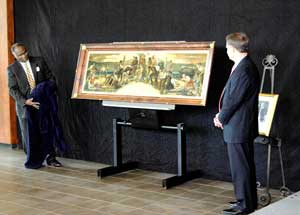Editorial
Front Page - Friday, May 7, 2010
Historical Society, Federal Bar unveil historic piece of art
David Laprad
 Chief U.S. District Judge Curtis Collier (left) and U.S. District Judge Harry Mattice unveil an artist’s study for the historic mural, “Allegory of Chattanooga,” which the court recently acquired, at the Chattanooga Theatre Center on April 27.
- David Laprad
Chief U.S. District Judge Curtis Collier (left) and U.S. District Judge Harry Mattice unveil an artist’s study for the historic mural, “Allegory of Chattanooga,” which the court recently acquired, at the Chattanooga Theatre Center on April 27.
- David Laprad
The Historical Society of the U.S. District Court for the Eastern District of Tennessee and the Chattanooga chapter of the Federal Bar Association on April 27 unveiled an artist’s study for the historic mural, “Allegory of Chattanooga,” which the court recently ac-quired, during a reception at the Chattanooga Theatre Center.
The mural, based on the study, adorns the wall behind the judge’s bench on the third story courtroom of the Joel W. Solomon Federal Building and U.S. Courthouse.
The mural, painted by Joseph Hilton Leech in the 1930s, offers a panorama of the people and events that are a part of Chattanooga’s history.
“My subject does not confine itself to any one event or place, but rather tries to portray a few highlights in history as they have happened in the State of Tennessee, and around Chattanooga in particular,” Leech said in 1937. “Using Chattanooga’s famous Lookout Mountain as my background, I tried to weave together in front of it a frieze of figures, singly and in groups, each a symbol of the life of that part of our country.
“Some I have used to represent its past history, others to illustrate its industries, and throughout, I tried to create a feeling of the potential powers and hopes for the future of the people.”
In his negotiations with the U.S. Treasury Department, which in those days supervised the construction of federal buildings, Leech submitted two studies for review. The studies were returned to Leech and remained in his art collection until his death in 1969, and then with his widow until her death in 2001. Their daughter inherited the studies, and in 2009, arranged to have an art dealer sell the collection.
Someone saw the mural for sale on eBay and notified Hamilton County Circuit Court Judge Neil W. Thomas III, who informed U.S. District Judge Harry Mattice of its availability. Mattice in turn asked the Court Historical Society to explore the possibility of the court purchasing the piece. The court then bought the study from the dealer.
A Washington, D.C. lawyer and art collector whose ancestors helped settle Decatur, Tenn., owns the other study.
Prints of the two studies and the mural were on display at the unveiling, allowing those in attendance to note several differences between the three paintings. For example, the study the federal court purchased features an African American convict and a cross held by a missionary. Leech omitted both from the mural.
A 1936 letter to the artist from Edward Rowan, superintendent of the Painting and Sculpture Section of the Treasury Department, reveals the behind-the-scenes process that led to the changes. In the letter, Rowan wrote, “It is understood that you are substituting the figure of the architect for the prisoner. The other two substitutions are additions to the general composition and it is agreeable that in the case of the missionary, the cross is omitted in accordance with the suggestion of Mr. Hunt.” (R.H. Hunt was the architect of the building.)
Ellen Simak, chief curator of the Hunter Museum of American Art, during a presentation following the unveiling, pointed out how the finished mural also features the Tenne-ssee Valley Authority dam more prominently than the studies.
“Seeing how the piece changed gives more resonance to the finished mural,” she said.
She then called attention to the things that did not change, such as the classical elements of the studies and the mural.
“The mural has a number of classical references, such as the reclining figure that fills the narrow spot in the lower left corner. That’s a classical motif you see as far back as the Parthenon.”
Simak also discussed how the allegorical nature of the paintings infuses them with meaning.
“The railroad, the agricultural workers and the wounded Confederate soldier were all important to the history of this city,” she said. “And the fact that these figures are general in nature allows for a broad interpretation of who they are and enables people to related to them in different ways.”
Art experts have praised the study, which measures 6 feet wide and 2 feet deep, as a significant purchase. Howard Hull, retired art history professor at the University of Tennessee at Knoxville, said, “It’s a wonderful acquisition. After all these years, it’s aesthetically pleasing and can be enjoyed historically.”
Simak also praised the purchase and said the court is fortunate the mural exists at all, since many courthouse murals have either been destroyed or painted over.
While admittedly not an art expert, Chief U.S. District Judge Curtis Collier during his keynote speech said the mural is relevant not only to Chattanooga and East Tennessee but to the U.S. as a whole. “East Tennessee has one of the richest histories of any region in the U.S.,” he said. “And this region has produced or been home to individuals who have played a major role in the life of our country. If you trace the history of East Tennessee, in many respects, you trace the history of the United States.”
As of the writing of this article, officials at the federal court had not yet decided where to display the study.
|
|